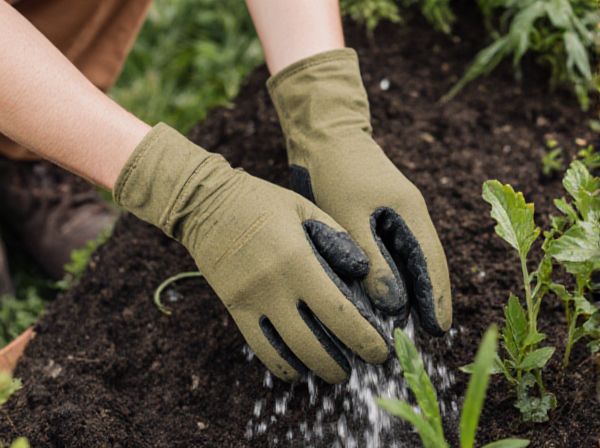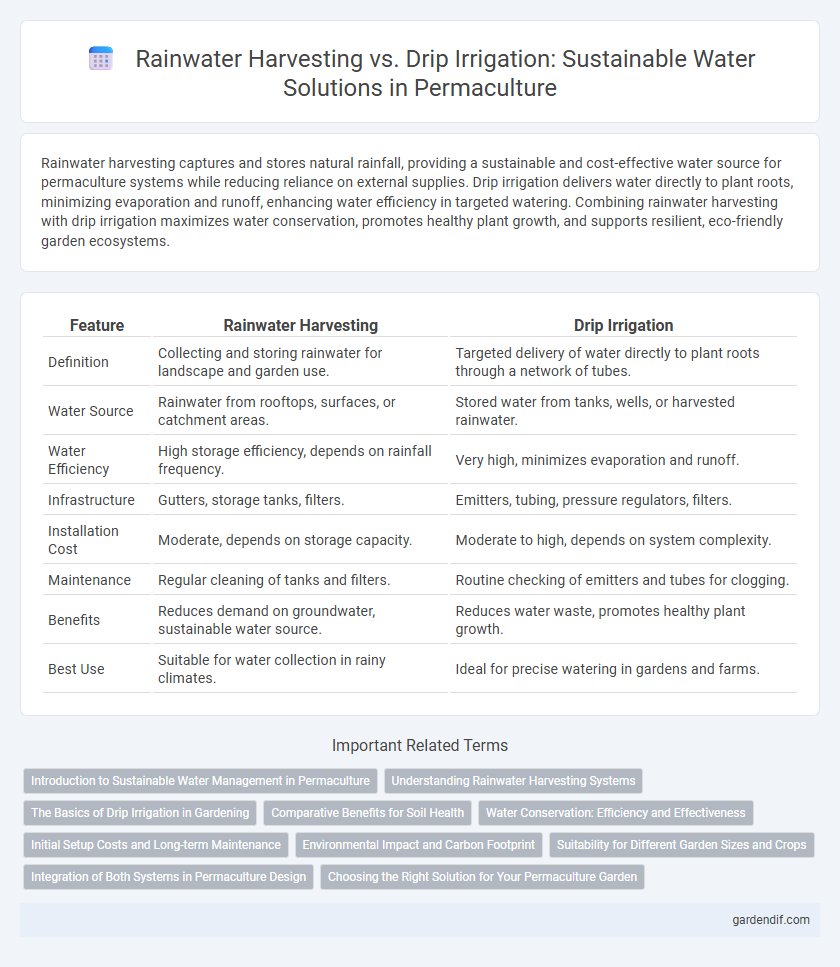
Rainwater Harvesting vs Drip Irrigation Illustration
Rainwater harvesting captures and stores natural rainfall, providing a sustainable and cost-effective water source for permaculture systems while reducing reliance on external supplies. Drip irrigation delivers water directly to plant roots, minimizing evaporation and runoff, enhancing water efficiency in targeted watering. Combining rainwater harvesting with drip irrigation maximizes water conservation, promotes healthy plant growth, and supports resilient, eco-friendly garden ecosystems.
Table of Comparison
| Feature | Rainwater Harvesting | Drip Irrigation |
|---|---|---|
| Definition | Collecting and storing rainwater for landscape and garden use. | Targeted delivery of water directly to plant roots through a network of tubes. |
| Water Source | Rainwater from rooftops, surfaces, or catchment areas. | Stored water from tanks, wells, or harvested rainwater. |
| Water Efficiency | High storage efficiency, depends on rainfall frequency. | Very high, minimizes evaporation and runoff. |
| Infrastructure | Gutters, storage tanks, filters. | Emitters, tubing, pressure regulators, filters. |
| Installation Cost | Moderate, depends on storage capacity. | Moderate to high, depends on system complexity. |
| Maintenance | Regular cleaning of tanks and filters. | Routine checking of emitters and tubes for clogging. |
| Benefits | Reduces demand on groundwater, sustainable water source. | Reduces water waste, promotes healthy plant growth. |
| Best Use | Suitable for water collection in rainy climates. | Ideal for precise watering in gardens and farms. |
Introduction to Sustainable Water Management in Permaculture
Rainwater harvesting collects and stores precipitation for irrigation, reducing reliance on external water sources and enhancing water conservation in permaculture systems. Drip irrigation delivers precise water amounts directly to plant roots, minimizing evaporation and runoff while maximizing efficiency. Combining these methods promotes sustainable water management by optimizing resource use and supporting resilient garden ecosystems.
Understanding Rainwater Harvesting Systems
Rainwater harvesting systems collect and store rainwater from rooftops or surfaces, providing a sustainable water source for permaculture gardens while reducing dependence on municipal supplies. These systems typically include gutters, filters, storage tanks, and distribution mechanisms optimized to maintain water quality and availability during dry periods. Properly designed rainwater harvesting enhances water conservation, supports efficient irrigation methods, and improves overall ecosystem resilience in permaculture practices.
The Basics of Drip Irrigation in Gardening
Drip irrigation is a highly efficient watering system in permaculture that delivers water directly to the plant roots through a network of tubes, emitters, and valves, minimizing evaporation and runoff. This method conserves water by targeting specific plants, promoting healthier growth and reducing weed proliferation compared to traditional watering techniques. Integrating drip irrigation with rainwater harvesting systems can further enhance sustainability by utilizing collected rainwater for precise irrigation needs.
Comparative Benefits for Soil Health
Rainwater harvesting enhances soil health by increasing moisture retention and reducing erosion, creating a natural irrigation source that minimizes dependency on external water supplies. Drip irrigation delivers water directly to plant roots, reducing water waste and preventing soil compaction while promoting nutrient absorption and microbial activity. Combining these techniques supports sustainable permaculture by conserving water and maintaining optimal soil structure and fertility.
Water Conservation: Efficiency and Effectiveness
Rainwater harvesting captures and stores natural precipitation, significantly reducing reliance on external water sources and enhancing water availability during dry periods. Drip irrigation delivers water directly to plant roots in controlled amounts, minimizing evaporation and runoff, which maximizes water use efficiency. Combining rainwater harvesting with drip irrigation optimizes water conservation, ensuring sustainable and effective irrigation in permaculture systems.
Initial Setup Costs and Long-term Maintenance
Rainwater harvesting systems typically require higher initial setup costs due to the need for storage tanks, gutters, and filtration components, but they offer low long-term maintenance with occasional cleaning and inspection. Drip irrigation systems involve moderate initial investment in tubing, emitters, and control units, while demanding consistent maintenance such as emitter cleaning and system checks to prevent clogging and leaks. Both techniques improve water efficiency in permaculture, but rainwater harvesting provides a sustainable water source, whereas drip irrigation optimizes water use directly on plants, influencing overall cost-effectiveness over time.
Environmental Impact and Carbon Footprint
Rainwater harvesting significantly reduces environmental impact by capturing natural precipitation, lowering dependency on municipal water sources, and minimizing energy consumption associated with water transport and treatment. Drip irrigation, while efficient in water usage by delivering moisture directly to plant roots, relies on energy-intensive pumping systems and plastic tubing, contributing to a higher carbon footprint. Combining rainwater harvesting with drip irrigation maximizes resource efficiency and minimizes overall environmental impact in permaculture systems.
Suitability for Different Garden Sizes and Crops
Rainwater harvesting is highly suitable for larger permaculture gardens and orchards where storing significant volumes of water supports diverse crop needs and seasonal variability. Drip irrigation excels in small to medium-sized gardens, delivering precise water directly to plant roots, optimizing water use for vegetables, herbs, and small fruit plants. Both methods can complement each other by integrating water efficiency tailored to garden scale and specific crop water requirements, enhancing sustainability.
Integration of Both Systems in Permaculture Design
Integrating rainwater harvesting with drip irrigation in permaculture design maximizes water efficiency by capturing and storing natural rainfall for targeted, low-flow delivery directly to plant roots. This combination reduces water waste, enhances soil moisture retention, and promotes sustainable garden productivity even during dry periods. Utilizing rainwater as the primary source in drip systems minimizes reliance on external water supplies, aligning with permaculture's principles of resource conservation and ecological balance.
Choosing the Right Solution for Your Permaculture Garden
Rainwater harvesting captures and stores natural rainfall, reducing dependence on external water sources and promoting sustainable water use in permaculture gardens. Drip irrigation delivers water directly to plant roots, enhancing water efficiency and minimizing evaporation and runoff in diverse garden conditions. Selecting between these systems depends on garden size, local climate, water availability, and specific plant needs to optimize resource use and support resilient, productive permaculture ecosystems.
Rainwater Harvesting vs Drip Irrigation Infographic

 gardendif.com
gardendif.com